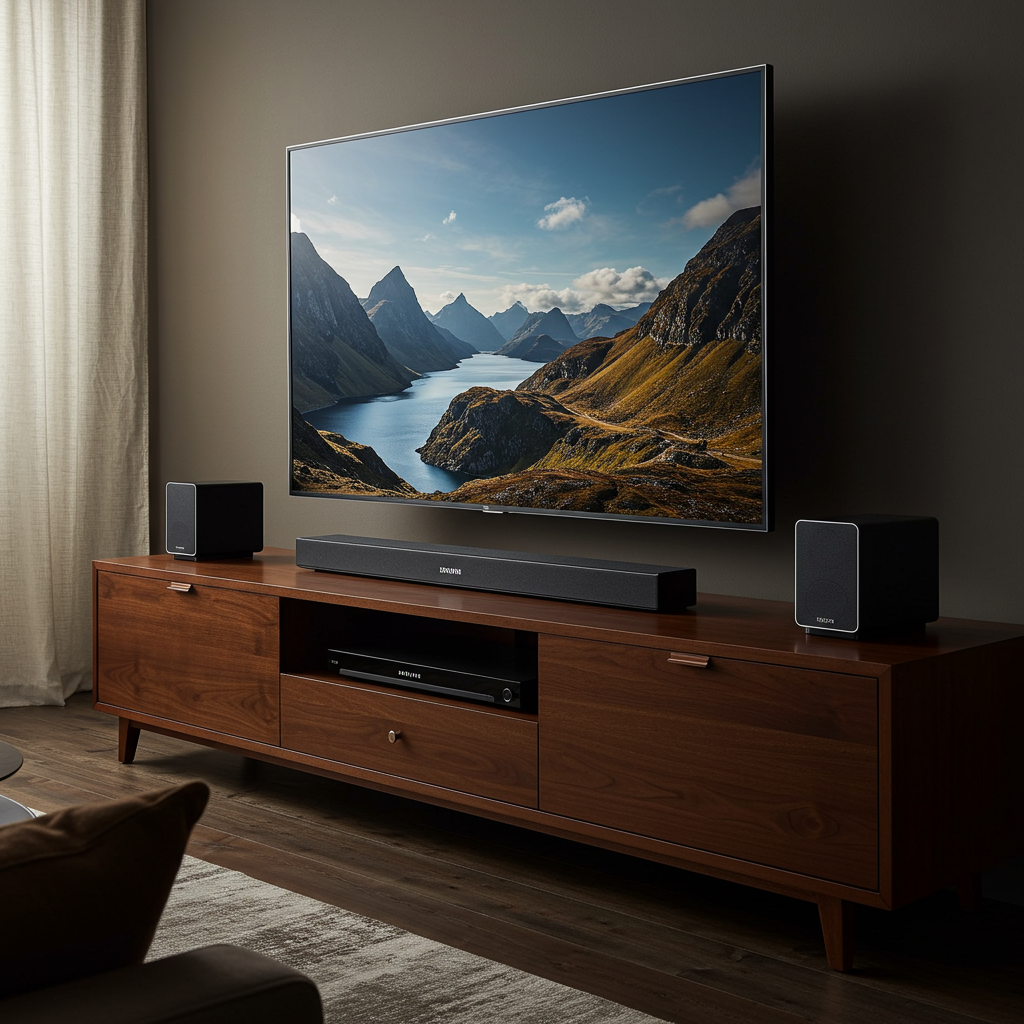Thinking about upgrading your TV audio? A premium soundbar system can transform your living room into a true home theater. But with top contenders like samsung and sonos vying for your attention, choosing the right flagship can be tough. We put Samsung’s latest premium package to the test against a high-end Sonos setup to see how they stack up. The results? Surprisingly close, but with key differences that could sway your decision.
Elevating Your TV Audio Experience
Gone are the days when built-in TV speakers were sufficient. To truly complement today’s large, high-definition displays, you need audio that delivers impact, clarity, and immersion. Adding a soundbar is the first step. Integrating a complete system with a subwoofer and dedicated rear speakers takes it to another level, creating a enveloping soundstage that pulls you into movies, shows, and games.
Samsung’s flagship HW-Q990F system aims to deliver this complete experience straight out of the box. It includes a main soundbar unit, a powerful wireless subwoofer, and two wireless rear satellite speakers. This full package boasts an impressive 11.1.4 channel configuration, leveraging 23 individual speakers to project sound around and above you.
For two weeks, this robust Samsung setup replaced a beloved high-end Sonos configuration consisting of the Sonos Arc Ultra soundbar paired with a Sonos Sub and Sonos Era 300 rear speakers. This provided a direct comparison between two distinct approaches to premium home audio: Samsung’s all-in-one flagship system versus Sonos’ top-tier modular components. Here’s a detailed look at how they performed head-to-head.
Design and Setup Impressions
First impressions matter, and both systems present a sleek, modern aesthetic designed to blend into contemporary living spaces.
The Samsung HW-Q990F is an imposing soundbar. Its size makes it ideally suited for pairing with larger televisions, specifically recommended for screens 60 inches or greater. While large, its soft black-grey finish and clean lines ensure it doesn’t look out of place beneath a big TV. The accompanying wireless subwoofer has been redesigned this year, adopting a more compact cubed shape compared to previous taller versions. The rear speakers are small but feel substantial. Setting up the Q990F is straightforward; the components pair wirelessly, minimizing cable clutter.
The Sonos Arc Ultra, part of the tested Sonos setup, also features a significant footprint. As Sonos’ latest flagship soundbar, it builds on the original Arc’s design with minor tweaks, including a slightly slimmer profile and a refined matte finish. Sonos systems are known for their simplicity in setup via the Sonos app. While the Arc Ultra handles fronts and some height channels, achieving a comparable immersive setup requires adding the Sonos Sub and Era 300 rear speakers, each adding their own presence (and power cords) to the room.
Connectivity and Smart Features Compared
Modern soundbars serve as the hub of your entertainment system, demanding versatile connectivity and smart home integration.
The Samsung HW-Q990F offers a comprehensive suite of connection options. It supports HDMI eARC 2.1, Optical, and Bluetooth. This allows it to handle high-bandwidth audio formats from compatible TVs and stream wirelessly from various devices. Furthermore, the Q990F boasts wide smart home and streaming platform compatibility. It works with Google Home, Chromecast, Spotify Connect, Roon, AirPlay, Tidal Connect, Alexa, and Bixby. If you own a compatible Samsung TV, features like Q-Symphony can sync the TV’s speakers with the soundbar for an even broader soundstage, adding a unique advantage for Samsung loyalists. The inclusion of HDMI passthrough ports is a significant plus for users connecting multiple sources like gaming consoles or Blu-ray players directly through the soundbar.
Sonos systems rely heavily on the Sonos app for setup, control, and multi-room audio integration. The Sonos Arc Ultra connects primarily via HDMI eARC. It supports AirPlay 2 for easy streaming from Apple devices and integrates seamlessly with numerous music services within the Sonos app. While Sonos excels in multi-room audio networking, its connectivity suite is generally simpler than Samsung’s. A notable point of comparison is the Sonos Arc’s lack of HDMI passthrough, meaning all sources must connect directly to the TV. Sonos also traditionally lacks support for DTS audio formats, a standard found on many Blu-rays and some streaming services, though this is less about connectivity and more about processing capability.
Audio Performance: The Critical Test
Ultimately, a soundbar system lives or dies by its sound quality. The comparison focused on how each system delivered movie soundtracks, TV dialogue, and music.
Both the Samsung HW-Q990F and the Sonos Arc Ultra setup proved capable of producing loud, room-filling sound with impressive immersion, particularly with Dolby Atmos content. Samsung’s 11.1.4 channel configuration, powered by its 23 speakers, creates a convincing dome of sound. Testing with action-packed scenes and dialogue-heavy shows demonstrated the system’s ability to handle dynamic shifts and deliver clear vocals. The included wireless rear speakers significantly enhance the spatial audio effect, accurately placing sounds within the environment as intended by the mix. Even with content not mixed for Atmos, like Multichannel PCM, the rear speakers add a valuable layer of immersion.
When comparing the low-frequency performance, the Samsung HW-Q990F’s external subwoofer delivers a powerful rumble suitable for cinematic explosions and impacts. However, in direct comparison, the bass wasn’t quite as “tight” or controlled as that from the Sonos Sub 4 used in the competing setup. The difference in physical size between the subwoofers likely plays a role here.
Moving to music playback, both systems perform well beyond just TV audio. The Samsung Q990F offers deep bass, clear midranges, and present highs. When pitted against the Sonos Arc Ultra, the Samsung system had slightly less “shine and crispiness” in the highest frequencies. The Sonos Arc Ultra, specifically, is designed with a focus on dialogue clarity and improved audio transparency, featuring a reconfigured center channel array and a Speech Enhancement option in the app. While not directly tested against the Samsung’s dialogue performance in the source material, this is a stated strength of the Arc Ultra. Sonos also highlights “Sound Motion” technology in the Arc Ultra, promising enhanced quality and balance, which adds another layer to its audio engineering.
A crucial technical difference lies in supported audio formats. The Samsung HW-Q990F supports a wide range, including Dolby Atmos, Dolby TrueHD, DTS Digital Surround, and Multichannel PCM. The inclusion of DTS support is a notable advantage for the Samsung system, particularly for users who own Blu-ray discs or access streaming content encoded in DTS formats, as Sonos systems typically do not support this format.
Price and Value Proposition
Comparing the cost is essential, as these are premium home theater solutions. This is where the Samsung HW-Q990F offers a compelling argument.
The Samsung HW-Q990F is sold as a complete 11.1.4 system, including the soundbar, subwoofer, and two rear speakers, typically priced around $2,000. It is often available with significant discounts, such as the $400 off (20%) deal mentioned, making it even more attractive.
The comparable Sonos setup involves purchasing the Sonos Arc Ultra soundbar, a Sonos Sub, and two Sonos Era 300 rear speakers separately. Since Sonos sells components modularly, building a system with this channel count and performance level results in a significantly higher total cost than the Samsung package. The Era 300 speakers, necessary to provide rear height channels comparable to the Samsung’s included rears, are a considerable investment on their own.
The value proposition is clear: Samsung provides a high-performance, high-channel count, immersive system in one box for considerably less money than assembling a similarly capable system from Sonos’ top-tier components. Sonos offers modularity and ecosystem benefits, but at a premium price.
Is it Time to Switch? Making the Decision
After extended testing, the Samsung HW-Q990F stands out as a very strong competitor to high-end modular Sonos setups. The comparison reveals that the Samsung system delivers performance that is “pretty dang close” to the Sonos Arc Ultra configuration, offering full-bodied, energetic, and immersive sound.
For those seeking a complete, high-channel count home theater system without the complexity and cost of buying individual components, the Samsung HW-Q990F is an excellent choice. Its support for a wide array of audio formats, including DTS, broad connectivity options, and feature-rich ecosystem make it particularly appealing. The value proposition, especially when discounted, is undeniable compared to building a comparable system with Sonos. It’s an ideal match for larger TVs and living rooms. However, if you own last year’s HW-Q990D, the incremental improvements in the Q990F might not warrant an immediate upgrade.
The Sonos Arc Ultra setup, on the other hand, appeals strongly to existing Sonos users or those prioritizing the Sonos ecosystem, its renowned multi-room capabilities, and potentially slightly more refined audio performance in certain areas (like high-frequency detail or sub ‘tightness’). The modularity allows users to build their system over time, though reaching the immersive level of the Q990F requires significant investment in the Sub and Era 300s. The lack of DTS support and HDMI passthrough are points to consider for home theater enthusiasts.
Ultimately, the choice depends on your priorities. If maximizing immersive sound, features, and value in an all-in-one package is key, the Samsung HW-Q990F is a formidable option that goes head-to-head with the best, including top-tier Sonos configurations.
Frequently Asked Questions
What is the channel configuration of the Samsung HW-Q990F system?
The Samsung HW-Q990F is configured as an 11.1.4 channel system. This setup includes channels from the main soundbar unit, one dedicated subwoofer channel, and four upfiring channels for height effects (some from the soundbar, some from the rear speakers). The system utilizes a total of 23 speakers strategically placed across the soundbar, subwoofer, and two wireless rear satellite speakers to create a comprehensive, immersive sound environment.
Does the Samsung Q990F or Sonos Arc Ultra setup support DTS audio formats?
The Samsung HW-Q990F system supports various high-quality audio formats, including Dolby Atmos, Dolby TrueHD, DTS Digital Surround, and Multichannel PCM. In contrast, Sonos systems, including the Sonos Arc Ultra soundbar, generally do not support DTS audio formats. This is a key difference, making the Samsung Q990F a better choice for users who specifically need DTS support, such as those who watch Blu-ray discs or content streams using that format.
Is the Samsung HW-Q990F a better value than a comparable Sonos setup?
Based on comparing the cost of the Samsung HW-Q990F as a complete package (soundbar, subwoofer, and rears) versus assembling a similarly high-channel count, immersive setup with Sonos components (Sonos Arc Ultra, Sonos Sub, Sonos Era 300 rears), the Samsung HW-Q990F typically offers better value. It provides a full-featured 11.1.4 system in a single purchase at a lower overall price point than the modular Sonos system, especially considering potential discounts on the Samsung.




